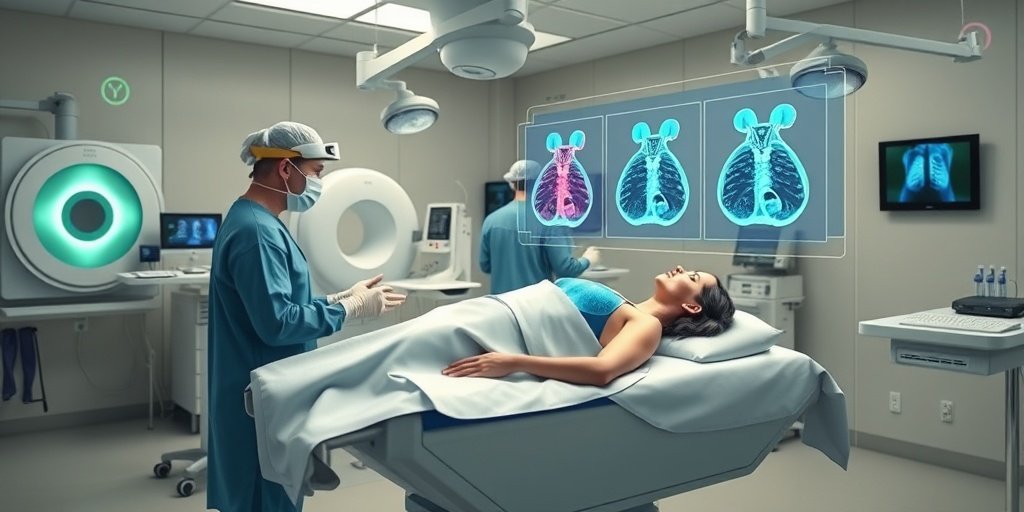⚡ Quick Summary
This article explores the role of advanced imaging technologies in autologous breast reconstruction (ABR), highlighting the significance of modalities such as ultrasonography (US), computed tomography angiography (CTA), and magnetic resonance angiography (MRA). The study emphasizes the potential of emerging technologies like augmented reality (AR) and artificial intelligence (AI) to enhance surgical outcomes and efficiency.
🔍 Key Details
- 📊 Imaging Modalities: Ultrasonography (US), Computed Tomography Angiography (CTA), Magnetic Resonance Angiography (MRA)
- ⚙️ Emerging Technologies: Real-time angiography, 3D surface imaging, Augmented/Virtual Reality (AR/VR), Artificial Intelligence (AI)
- 🏥 Focus: Enhancing perioperative efficiency and reducing donor-site morbidity
🔑 Key Takeaways
- 🔬 Imaging advancements are crucial in the management of autologous breast reconstruction.
- 📈 Technologies like CTA and MRA are extensively researched and utilized in clinical settings.
- 🤖 Future prospects include the integration of AI and AR/VR to improve surgical outcomes.
- 💡 Real-time imaging can significantly enhance perioperative efficiency.
- 🌟 Reduced donor-site morbidity is a key benefit of improved imaging techniques.
- 📅 Study published in the journal Cancers (Basel) in 2024.
- 📝 Authors: Coleman-Belin JC, Barnett J, Khavanin N, Nelson JA, Stern CS, Allen RJ.

📚 Background
The field of autologous breast reconstruction has seen significant advancements, particularly in the realm of imaging technologies. These innovations are reshaping clinical management and enhancing the precision of surgical procedures. As the demand for effective and aesthetically pleasing reconstruction options grows, the integration of advanced imaging modalities becomes increasingly vital.
🗒️ Study
The study conducted by Coleman-Belin et al. focuses on the evolution of imaging in ABR, examining the most researched modalities such as ultrasonography, CTA, and MRA. The authors discuss ongoing advancements, including the development of real-time angiography and 3D surface imaging, which promise to revolutionize surgical practices.
📈 Results
The findings indicate that the incorporation of advanced imaging technologies can lead to improved surgical outcomes, including enhanced perioperative efficiency and reduced donor-site morbidity. The potential future applications of AR/VR and AI in this field are particularly promising, suggesting a transformative impact on surgical practices.
🌍 Impact and Implications
The implications of this research are profound. By leveraging advanced imaging technologies, healthcare professionals can achieve better surgical outcomes and enhance patient satisfaction in ABR. The integration of AI and AR/VR could further streamline surgical processes, making them safer and more efficient. This evolution in imaging not only benefits patients but also supports surgeons in delivering high-quality care.
🔮 Conclusion
The study underscores the critical role of advanced imaging technologies in the field of autologous breast reconstruction. As we look to the future, the integration of AI and AR/VR holds the promise of further enhancing surgical outcomes and patient experiences. Continued research and development in this area are essential for advancing surgical practices and improving patient care.
💬 Your comments
What are your thoughts on the advancements in imaging technologies for breast reconstruction? We would love to hear your insights! 💬 Share your comments below or connect with us on social media:
Imaging in Autologous Breast Reconstruction.
Abstract
The evolution of imaging actively shapes clinical management in the field. Ultrasonography (US), computed tomography angiography (CTA), and magnetic resonance angiography (MRA) stand out as the most extensively researched imaging modalities for ABR. Ongoing advancements include “real-time” angiography and three-dimensional (3D) surface imaging, and future prospects incorporate augmented or virtual reality (AR/VR) and artificial intelligence (AI). These technologies may further enhance perioperative efficiency, reduce donor-site morbidity, and improve surgical outcomes in ABR.
Author: [‘Coleman-Belin JC’, ‘Barnett J’, ‘Khavanin N’, ‘Nelson JA’, ‘Stern CS’, ‘Allen RJ’]
Journal: Cancers (Basel)
Citation: Coleman-Belin JC, et al. Imaging in Autologous Breast Reconstruction. Imaging in Autologous Breast Reconstruction. 2024; 16:(unknown pages). doi: 10.3390/cancers16162851